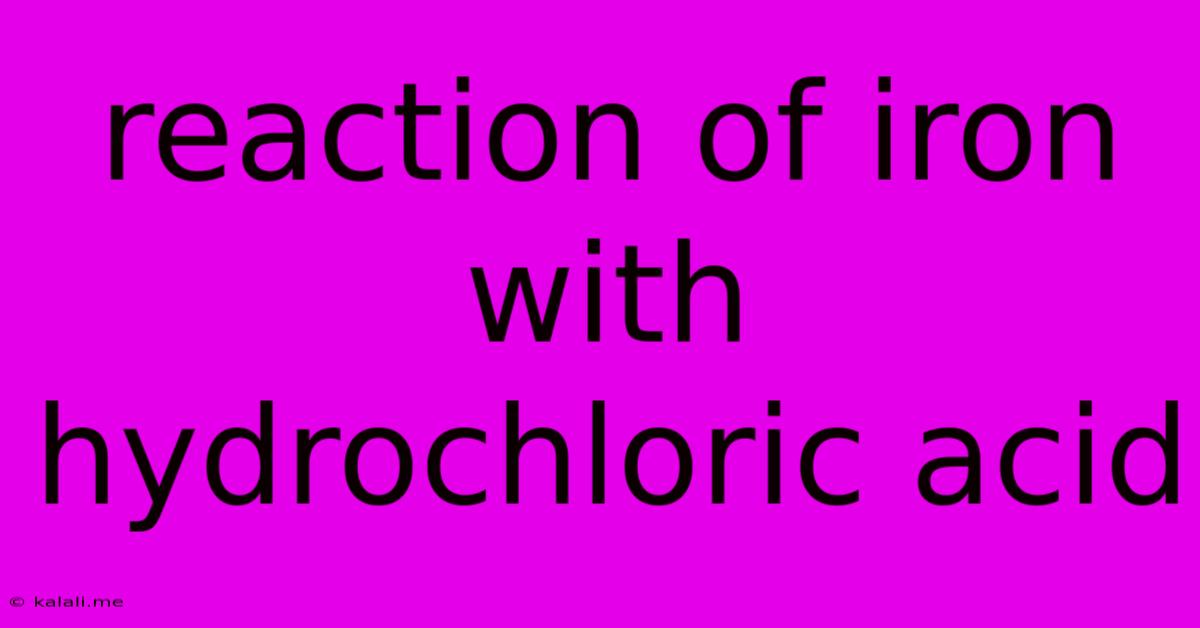Reaction Of Iron With Hydrochloric Acid
Kalali
Jun 14, 2025 · 3 min read

Table of Contents
The Reaction of Iron with Hydrochloric Acid: A Comprehensive Guide
The reaction between iron and hydrochloric acid is a classic example of a single displacement reaction, also known as a single replacement reaction, frequently explored in chemistry classrooms and relevant to various industrial processes. Understanding this reaction involves examining its chemical equation, the factors influencing its rate, and the practical applications it holds. This article will delve into all these aspects, providing a comprehensive overview for students and enthusiasts alike.
The Chemical Equation and Reaction Mechanism
The reaction of iron (Fe) with hydrochloric acid (HCl) produces iron(II) chloride (FeCl₂) and hydrogen gas (H₂). This is a redox reaction, meaning it involves both oxidation and reduction. Iron is oxidized, losing electrons to become the Fe²⁺ ion, while hydrogen ions (H⁺) in the hydrochloric acid are reduced, gaining electrons to form hydrogen gas. The balanced chemical equation is:
Fe(s) + 2HCl(aq) → FeCl₂(aq) + H₂(g)
The reaction proceeds through several steps. Initially, the iron atoms on the surface react with the hydrogen ions from the hydrochloric acid. This involves the transfer of electrons from the iron atoms to the hydrogen ions. The hydrogen atoms then combine to form diatomic hydrogen gas, which is released as bubbles. The iron(II) ions (Fe²⁺) remain in solution, combining with chloride ions (Cl⁻) to form iron(II) chloride. The overall reaction is exothermic, meaning it releases heat. You'll observe that the solution becomes warm as the reaction proceeds.
Factors Affecting the Reaction Rate
Several factors influence the rate at which iron reacts with hydrochloric acid. These include:
-
Concentration of Hydrochloric Acid: A higher concentration of HCl means a greater number of hydrogen ions available to react with the iron, leading to a faster reaction rate. More collisions occur per unit time, increasing the likelihood of a successful reaction.
-
Surface Area of Iron: A larger surface area of iron, such as using iron filings instead of a solid iron block, increases the contact area between the reactants, accelerating the reaction rate. More iron atoms are exposed to the acid, leading to a greater number of simultaneous reactions.
-
Temperature: Increasing the temperature increases the kinetic energy of the reacting particles. This leads to more frequent and energetic collisions, thus increasing the reaction rate. The reaction is faster at higher temperatures.
-
Presence of Impurities: Impurities on the surface of the iron can act as catalysts or inhibitors, influencing the reaction rate. Some impurities might speed up the reaction while others could slow it down.
Safety Precautions
When conducting this experiment, several safety precautions should be observed:
- Always wear appropriate safety goggles to protect your eyes from splashes of acid.
- Perform the experiment in a well-ventilated area or under a fume hood to avoid inhaling hydrogen gas. Hydrogen gas is flammable and can form explosive mixtures with air.
- Handle hydrochloric acid with care, as it is corrosive. Use appropriate gloves and lab coat for protection.
- Dispose of the waste properly according to your institution's guidelines.
Applications
The reaction of iron with hydrochloric acid has several practical applications:
- Production of Iron(II) Chloride: Iron(II) chloride is used as a reducing agent and a mordant in the textile industry, as well as in water treatment.
- Cleaning of Iron Surfaces: This reaction can be used to clean iron surfaces by removing rust and other impurities.
- Laboratory Experiments: It's a common demonstration experiment in chemistry classrooms to illustrate redox reactions and the production of hydrogen gas.
Conclusion
The reaction between iron and hydrochloric acid is a fundamental chemical process with significant practical implications. Understanding the factors influencing its rate allows for better control and optimization in various applications. Remember always to prioritize safety when conducting experiments involving acids.
Latest Posts
Latest Posts
-
What Are The Multiples Of 23
Jun 14, 2025
-
How To Spell 100 In Words
Jun 14, 2025
-
Which Of The Following Statements About Motivation Is Incorrect
Jun 14, 2025
-
Chairman Of Press Trust Of India
Jun 14, 2025
-
Which Of The Following Statements Is True Of Globalization
Jun 14, 2025
Related Post
Thank you for visiting our website which covers about Reaction Of Iron With Hydrochloric Acid . We hope the information provided has been useful to you. Feel free to contact us if you have any questions or need further assistance. See you next time and don't miss to bookmark.